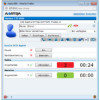Aastra ACD 100 Manuals Aastra ACD 100 - Page 20
Telephony > Lists > Selective, Call forwarding, Ph.No., Phone No., Status, Source - ad
 |
View all Aastra ACD 100 manuals
Add to My Manuals
Save this manual to your list of manuals |
Page 20 highlights
ACD System Configuration 1. Click on the New button above the table on the Telephony > Lists > Selective Call forwarding status page to configure new call forwarding. In order to change the settings of existing call forwarding, click on the desired entry in the Ph.No. table column. The configuration dialogue opens. 2. Phone No.: This is where you enter the "normal" call number of the ACD group. 3. Status: Click on the Status option to activate/deactivate the call forwarding. A checkmark indicates that the call forwarding is activated. 4. Source: Enter the call number of the caller. You can enter an internal call number or a complete (individual) external call number including a reseizure code or comprise a call number range: - Use a wildcard character (asterisk = "*") to extend a call number to comprise a range of call numbers. Example: 00301234* applies to all calls which come in via the bundle with the "0" reseizure code and begin with 0301234. The wildcard character can be added at the beginning, at the end, or at the beginning and at the end. - If you only enter the seizure code of a bundle into the input field, this entry refers to calls where the call number is suppressed. - If you have activated the E.164 conversion feature, this is where you have to enter the call number of the caller, including the reseizure code and international prefix (example: 000493061041234). This feature is configured when you configure the bundle configuration or when you configure an SIP line. Refer to the "Mounting and Commissioning" guide (OpenCom X320, OpenCom 130/131/150, OpenCom 150, Aastra 104/108/112) or "Installing and Commissioning" guide (Aastra 800) for information on the "E.164 Conversion" topic. 18















